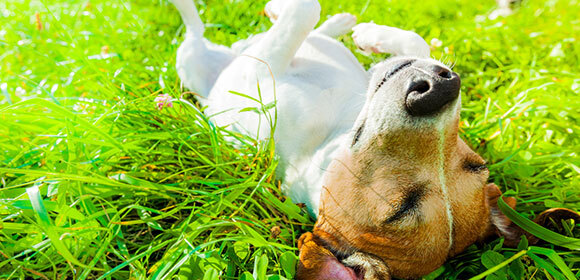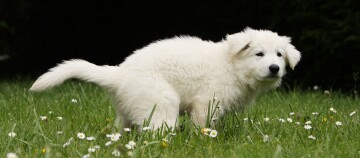Recognizing Fleas and Grass Mites in Dogs
02.05.2025 - Reading time: 4 minutes

Fleas and grass mites bite, suck, and cause severe itching, red spots, and localized hair loss in dogs. Heavy infestations can lead to anemia. By swallowing fleas, dogs can become infected with tapeworms and develop allergies. Learn how to quickly recognize and efficiently eradicate flea and grass mite infestations!
- Understanding Flea Infestations: How They Occur and Progress
- The Spread of Fleas
- Winter Flea Prevention Tips
- Identifying Fleas in Your Dog
- Effective Control and Prevention
- Step 1: Eliminate Adult Fleas and Their Brood
- Step 2: Remove Flea Brood from the Environment
- Step 3: Preventive Measures
- Fleas Transmit Diseases: Preventative Actions
- Identifying and Combating Grass Mites in Dogs
- Flea Facts and Information
- Grass Mite Facts and Information
Understanding Flea Infestations: How They Occur and Progress
Fleas naturally inhabit grass, fields, and bushes but can also be found indoors, waiting for a host to pass by. These 3 mm bloodsuckers have an enormous jumping power of up to 1 m across and 25 cm high! Fleas are brownish, narrow, flat, and wingless, with six legs and strong hind legs for jumping.
There are thousands of flea species worldwide, including dog fleas (Ctenocephalides cani), cat fleas (Ctenocephalides felis), and human fleas (Pulex irritans). Interestingly, the most common flea on dogs is the cat flea, while dog fleas are rare. Fleas can also infest humans as “false hosts” when the primary host is absent.
Rapid Flea Multiplication and Spread
A female flea lays her first eggs after her first blood meal, producing 27-50 eggs per day in the dog’s fur. These smooth eggs fall off and hatch in optimal conditions (25°C and 80% humidity). Larvae crawl into dark places to pupate in cocoons, hatching after 10 days when they sense warmth, CO2, and vibrations. Fleas can move from one dog to another but prefer staying on their host.
Flea Infestation in Homes
Even a few fleas can lead to hundreds of eggs and larvae in carpets, dog baskets, upholstery, and textiles. Larvae can survive up to six months without a blood meal, leading to difficult-to-contain infestations. Early precautions and immediate action are crucial.
Winter Flea Prevention Tips
Fleas seek warmth during winter, transferring into homes via wild animals. Protect your dog with natural spot-on preparations, vermin tapes, and flea powder. Treat surroundings with pest sprays and follow up with anthelmintic therapy to prevent worm transmission. Persistent infestations require a vet visit. Find suitable products in our online shop.

Designpics/stock.adobe.com
Recognizing Fleas and Grass Mites in Dogs – Here's What to Do!
The first sign of a flea or mite infestation is intense itching caused by the saliva of these pests, followed by your dog’s persistent scratching. Some dogs might also bite or nibble at the affected areas.
Identifying Fleas and Mites
Determining whether your dog has fleas or grass mites can be tricky. Not all dogs scratch enough for you to notice, and detecting fleas in thick fur can be a matter of luck. Early infestations might go unnoticed, leading to a larger problem later.
Simple Flea Test
- Use a flea comb (a fine, close-meshed comb) and a damp, light-colored cloth or kitchen paper.
- Comb your dog’s coat against the direction of growth and tap the comb on the damp cloth.
- Look for black-brown particles. Crush them on the cloth or wipe the comb over it.
- If the particles turn rusty brown to reddish or form a red ring, it’s flea excrement (digested blood).
- If they don’t change color, it’s just dirt.
Controlling and Preventing Fleas
By the time you notice fleas on your dog, there’s likely a significant infestation in your home. Only 5% of fleas live on their host; the rest are in the environment as eggs, larvae, and pupae. Treating your dog alone won’t suffice; you must also address the environment.
Step 1: Eliminate Adult Fleas
Use a vet-prescribed insecticide to kill adult fleas (shampoos, powders, sprays) and an insect development inhibitor to destroy eggs. Follow the manufacturer’s instructions and consult your vet, as these products are toxic. Treat all pets in your household.
Step 2: Remove Fleas from the Environment
This can be achieved by strictly adhering to the following measures:
- Mop floors and corners daily, vacuum carpets and upholstery, and dispose of the dust bag immediately.
- Wash dog blankets, basket pads, pillows, and textiles frequently. Dry clean sofa covers if needed.
- Don’t forget stuffed animals.
- Change bed linen daily if your dog sleeps in your bed.
- Wash all textiles at a minimum of 60°C.
- Apply anti-flea powder to your dog’s resting areas and use environmental sprays from your vet.
- Use flea foggers for heavy infestations, ensuring all pets and people leave the room for at least two hours.
- Treat garages, cars, and storerooms similarly. Continue these measures for three months to ensure all eggs and larvae are eradicated.
Step 3: Preventive Measures
Use special antiparasitics like spot-on treatments or flea collars. The best options have a repellent or knock-down effect to prevent bites, especially important for dogs with flea allergies. Consult your vet for advice.
Preventative Measures Against Flea-Transmitted Diseases
Fleas can transmit the cucumber tapeworm (Dipylidium caninum) when bitten or swallowed by your dog. A worming treatment is essential after flea treatment. Flea saliva can also cause serious allergies, known as flea dermatitis.
Symptoms of Flea or Grass Mite Allergy
- Frequent and severe scratching and self-biting
- Raw areas of skin and blisters
- Hair loss on the back, hind legs, or base of the tail
- Redness and skin changes, such as “hot spots” (hot, red areas of skin), especially at the base of the back and inner thighs
- Red puncture marks surrounded by a reddened halo
- In extreme cases: changes in behavior (nervousness, anxiety, aggressiveness) due to intense itching and painful inflammation
Treatment for Flea and Mite Allergy
The first priority is to control fleas and mites on the dog and in its environment using special medication from the vet. Prophylaxis with spot-on preparations or flea collars is only effective if these products contain a repellent effect.
Identifying and Combating Grass Mites in Dogs
Grass mite larvae, also known as harvest mites, cause problems for dogs and humans. These mites are barely visible, about 0.3 mm in size, but their orange-red bodies make them easier to spot. Grass mite larvae appear from March and prefer grass, straw, and knee-high plants. To check for mites in your garden, place a light-colored cloth on the lawn in summer; mites will gather on it.
Grass mites affect areas of the dog’s body that come into contact with grass: paws, head, ears, legs, belly, and chest. They seek out thinner skin, scratch it, and release a salivary secretion.
Simple Test for Detecting Grass Mites in Dogs
- Place your dog on a white cloth and brush it with a flea comb, as you would for a flea test.
- Look for red spots in the coat while brushing. Tap the comb on the cloth to make the red spots more visible.
Grass mite saliva triggers intense itching. Unlike fleas, grass mites prefer cellular and lymphatic fluids and do not transmit diseases. However, they can cause trombidiasis in humans and mite allergies in dogs. The itching intensifies with scratching and warmth.
Preventing and Treating Grass Mite Infestations
- Change your walking route during mite season to use more paved paths.
- After walking in fields, spray off affected areas or the entire dog with water.
- Treat itching with a “paw bath” made of curd soap and warm water, then rinse thoroughly.
- Home remedies like olive oil, apple cider vinegar, a weak alcohol solution, and salt water can help relieve itching. Lightly disinfect the area.
- If the whole body is affected, bathe the dog.
- Rub bite sites with disinfectant and anti-itch salve.
- Cut your lawn frequently and treat it with a mixture of stinging nettles to kill larvae. Dispose of the cuttings immediately.
- Clean your living area thoroughly with water and vacuum or wash your dog’s bed.
- For severe or frequent infestations, and mite allergies, consult your vet for appropriate treatments.


